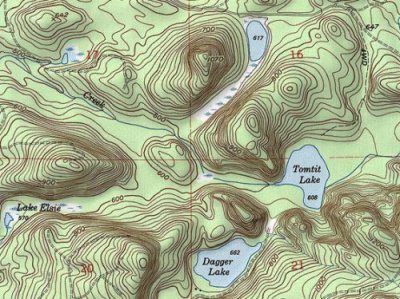How to Read a Map
Topographic Maps

Carrying and knowing how to read a map in the outdoors is an essential wilderness survival skill.
One of the most practical types of maps to have, especially when traveling in the outdoors, is a topographic map. Topographic maps present a straightforward, easy to understand visual aid for navigating a landscape. They are organized in a manner to help you navigate and plan routes through even the most challenging landscapes.
In order to help you understand how to read a map, let's start by breaking it down and looking at the basics.
The Four Cardinal Directions
Topographical maps are always arranged so that the four cardinal directions are obvious and easily understood. As with most maps, North is up on map. South is the bottom, while East is the right side and West is the left side of the printed map. There is also often a compass, arrow or magnetic declination character printed on the topographic map that points to North. Maps are oriented to True North, not magnetic North. Most topographic maps have the difference between magnetic and True North printed on the map for that region.
Contour Lines
This is a feature unique to topographical maps. Contour lines are curved lines that are used to connect points with the same elevation. In other words, contour lines give you a 3 dimensional lay of the land. They are used to define the shape and steepness in elevation of various landforms. To make contour lines most useful to you, you need to determine the contour interval which is generally given at the bottom of the map. The contour interval is the rate at which your elevation changes as you go from one contour line up or down to another, and this is general given in feet or meters.
Be More Prepared For Your Next Outdoor Adventure!

Don't leave home without knowing these six essential survival skills. Our free survival mini guide reveals the strategies of:
- Shelter & fire to prevent the number one cause of death
- Obtaining clean water to avoid life-threatening dehydration
- Common wild survival foods and other critical skills!

How to Read a Map's Scale
This is a vital part of the map that tells you have how the map relates to the landscape. Generally, map scale is given in 2 different ways on a topographical map: ratio scale and graphic scale.
The ratio scale is generally given in a number that looks something like this: 1:30,000. This means that for every 1 inch on the map, it is 30,000 inches on the ground.
The graphic scale is given as a line that demonstrates how long a given distance is using a straight line, which can be given as a mile or hundreds of miles. Often, there are multiple lines for this, one given in miles and another in kilometers. This acts as a visual ruler than can be quickly used to estimate distances using straight lines.
Map Legend
The legend is the portion of the map, also known as a "map key," that tells you how to read a map's details. Roads, buildings, waterways, glaciers, open versus forested terrain, and other features will be described in detail in the map legend. Generally, waterways are marked out in blue on topographic maps, while roads are marked out in black.
These basic map-reading techniques will help you stay safe while travelling in the backcountry. Map reading is even important if you plan to explore off trail. Utilizing a map and compass is paramount to preventing wilderness survival emergencies that result from getting lost. With these map reading skills, you'll be better prepared for your next outing.
By the way, if you enjoyed this article then you'll love our survival mini guide. You'll discover six key strategies to staying alive in the outdoors plus often-overlooked survival tips. We're currently giving away free copies here.
Further Resources:
To navigate effectively, using the combination of a topographic map paired with a compass. Check out our article on: How to Read a Compass.
For more information, visit How To Read Topographic Maps from the USGS.
Learn about Alderleaf's Courses

About the Author: Filip Tkaczyk is a periodic guest teacher at Alderleaf. He also wrote the field guide Tracks & Sign of Reptiles & Amphibians. Learn more about Filip Tkaczyk.
Return from How to Read a Map to Wilderness Articles
Is The Essential Wilderness Survival Skills Course Right for You? Take the "Online Survival Training Readiness" Quiz
See for yourself if this eye-opening course is a good fit for you. It takes just a few minutes! Get your Survival Training Readiness Score Now!

Grow Your Outdoor Skills! Get monthly updates on new wilderness skills, upcoming courses, and special opportunities. Join the free Alderleaf eNews and as a welcome gift you'll get a copy of our Mini Survival Guide.

 The Six Keys to Survival: Get a free copy of our survival mini-guide and monthly tips!
The Six Keys to Survival: Get a free copy of our survival mini-guide and monthly tips!
Learn more